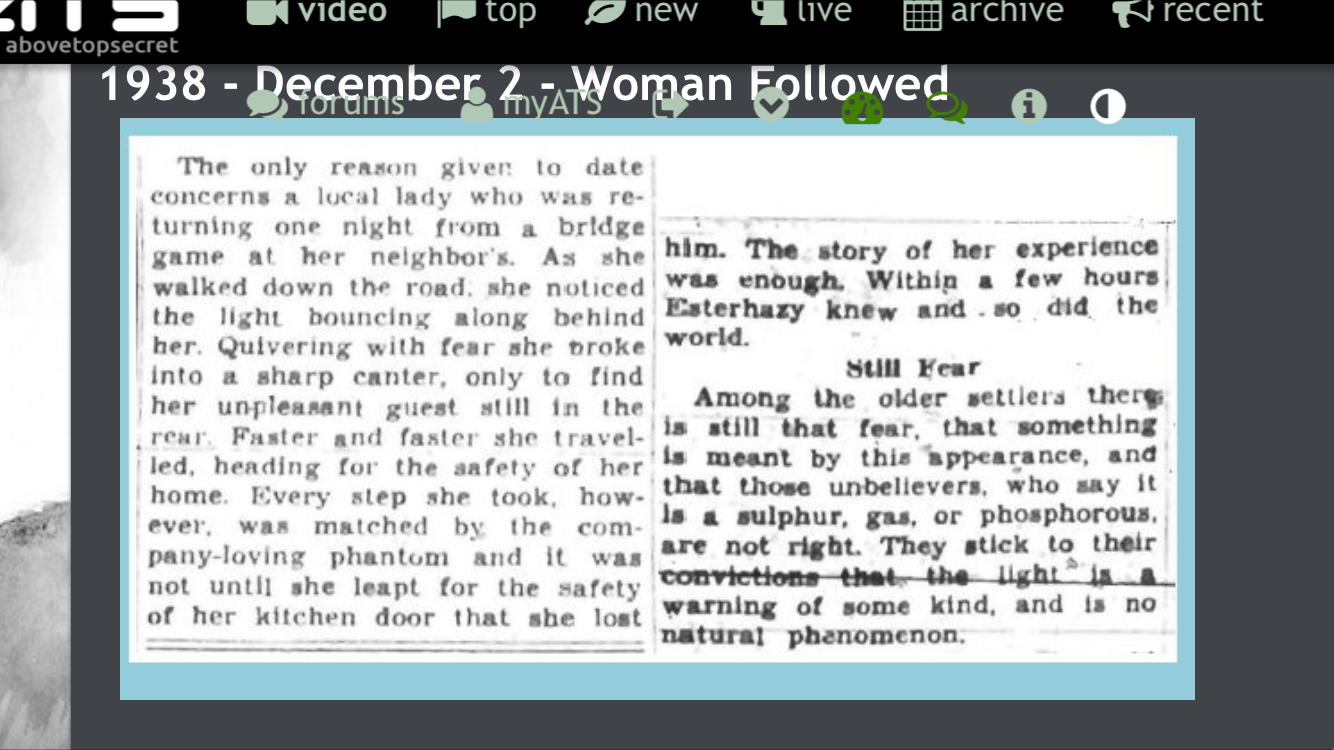It looks like you're using an Ad Blocker.
Please white-list or disable AboveTopSecret.com in your ad-blocking tool.
Thank you.
Some features of ATS will be disabled while you continue to use an ad-blocker.
share:
Back in the late 1930s, a small Canadian community found itself transfixed by a strange light in and around a cemetery. The light could be seen from
miles away as well as close-up and, within days, had generated enough attention that up to a hundred people would gather in late-night parties to see
it. The local press called it the ‘Tabor Light’ after the Tabor cemetery from where the light appeared to originate…
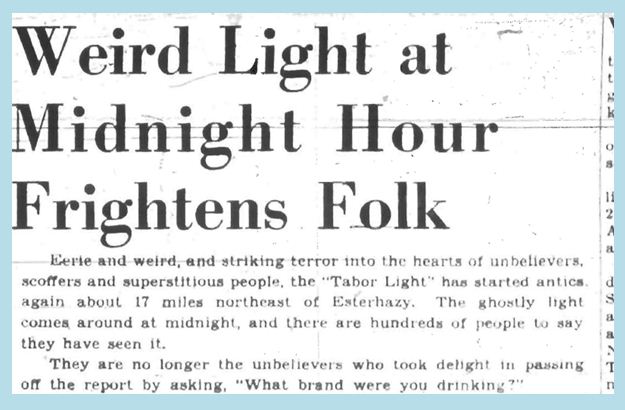
Thanks to the excellent work of Rick Fowler at the Saskatchewan Files website many of the original newspaper articles are available to read.
The background to these events is quite fascinating as it involves the redemption of a remorseful priest, a lost soul and the extraordinary activities of human nature at its most absurd. However, aside from the rampant superstitions and familiar squabbles between skeptical and believing minds, a singular light was reportedly seen that remains lost to time and unexplained.
Although there appears to have been an occasional and anecdotal history of an unusual light in the area, it was during November 1938 when repeated sightings began to gather pace. It was usually described as being a bright white light that appeared near a cemetery. It didn’t illuminate its surroundings and displayed quite erratic behaviour by appearing, disappearing and allegedly following people.
In one apparent incident, a policeman was driving past the cemetery when he saw an oncoming headlight. As he prepared to pull the motorist over for having only one light, it passed by unconnected to anything. Another report described a motorist ditching his car to avoid a collision with what must have looked like an oncoming vehicle.
Skeptics, motorists and the police
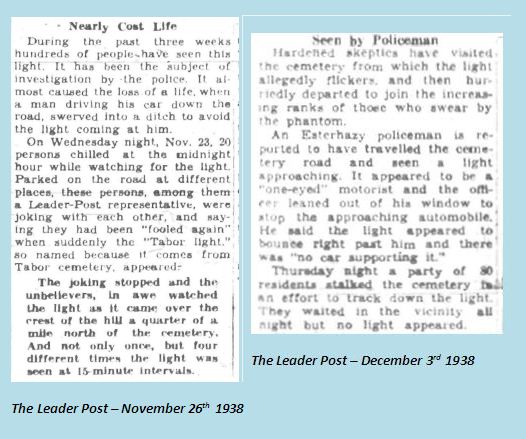
Rational minds sought to identify the light as reflecting car headlights but their attempts to prove it were unsuccessful. They found unbroken snow at locations the light had been and, in one experiment, everyone turned their lights off and still the light appeared several times. According to some reports, the light had followed pedestrians down lanes either from behind or alongside.
Pre-War and post-drought, the area was a cosmopolitan mix of pioneering Hungarians, Ukrainians, Belgians, French and British. The population was a classic cross-section of ‘30s society with poor farmers living alongside wealthy professionals. Apart from improved technology, many life-styles and belief-systems were barely changed from the 19th Century and, for some, the notion of curses, witches and walking ghosts were an obvious explanation for the light.
It was amidst all this clashing of beliefs and conflict between the scientific age and old-world religion that attempts to identify the light failed. In the newspaper articles we see the familiar performance of people declaring the explanations without ever demonstrating them. Therefore the light was ‘phosphorous’ or it was ‘marsh gas.’ It was a ‘lost soul’ or it was a ‘hoax.’ Dr. Gordon H. Shrum, physics professor at the University of British Columbia, decided it was ‘some form of electrical discharge.’ Another said it was ‘probably’ a ‘glowing owl.’
It was all things to anyone who was interested and times haven’t changed much since.
When we tread lightly through life’s mysteries, it is often the case that confirmation bias walks behind and informs the way we make sense of the unknown. Like it or not, knowingly or otherwise, people will always tend towards an answer that jigsaws neatly into their belief-systems. Of course, some explanations will transcend beliefs and personal opinions by being repeatable and provable such as diffracting headlights.
In the case of Father Pirot, he took a superstitious and religious position…
As the local priest, Father Jules Pirot advised the public to pray to God if they saw the light (this was an extraordinary man). His flock included a farming community that was steeped in the old-country superstitions of the past. He was interviewed for the paper and took a fairly predictable stance…
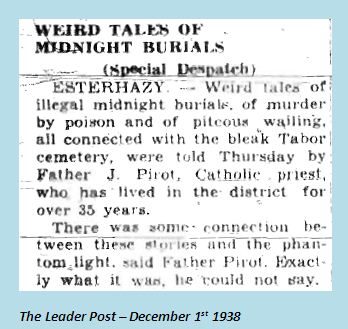
Father Pirot went on to describe the local belief that the Tabor cemetery was originally created by atheists and that such dark-doings would be a likely outcome for a graveyard conceived in unholy circumstances. Such beliefs were likely confined to the more superstitious of his flock. Where Pirot demonstrates the confirmation bias within us all is in his startling explanation some days after this article. He claimed the 'Tabor Light' was a sign from God after he had buried a young girl without last rites...
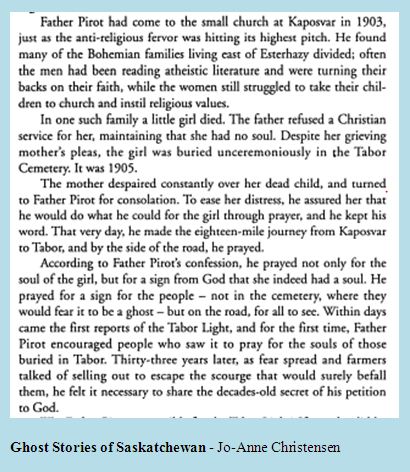
Ghost Stories of Saskatchewan - Jo-Anne Christensen
The times, the population and the location all seem to have come together to create a fizzing maelstrom of rumour, superstition and fears. In similar cases of 'spook lights' explanations were advanced that passing headlights were being diffracted under peculiar weather conditions. Could this be the case at the Tabor cemetery?
I’m not so sure. The light was reported as usually travelling in a north to south direction with less frequent reports of south to north. The geography is suitable for headlights flashing and being diffracted as there are hills in the region and the snowy landscape would be reflective as well as creating clear conditions. In particular, I wonder if a night train passed the area on those wintry nights?
Some reasons why I don’t favour vehicle headlights begin with the variety of reports. From following people, to passing down roads it seems unlike the reflected beams of headlights. Likewise, the light was generally described as self-contained and non-illuminating – it was a distinct form in the reports. The other explanations that are contained within the pages of the articles are similarly unappealing. If it was similar in origin to the Marfa Lights we'd expect the light to be seen from one location and would tend to be confined to a particular stretch of road.
1938 - December 2 - Woman Followed
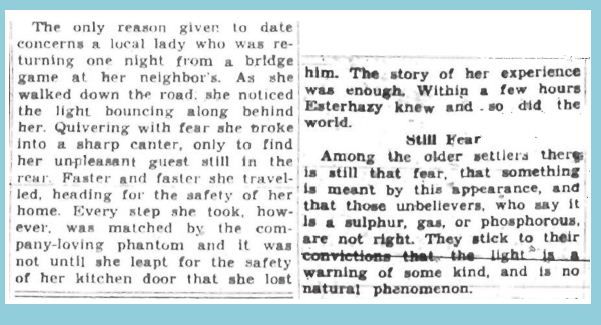
Essentially, there were enough incidents of the light to generate a lot of public interest and yet the tales never really left the boundaries of Saskatchewan. The war in Europe ensured that people had greater things to worry about – with over a million Canadians wearing the uniform. The Tabor Light has been lost to history and only lives on in the recollections of those who were there or their families.
In recent weeks, I’ve been seeking the assistance of the staff at The Leader Post and a Mr Will Chabun (veteran reporter and very decent guy) has been very helpful. He can recall his parents talking about the Tabor Light in the early 60s and hasn’t heard it mentioned until now. I wonder how many more people can remember a time when the Tabor Light fascinated so many people? Without the efforts of Mr Fowler and his website, the excitement surrounding the ‘Tabor Light’ would be a faint flicker fading away in time.


Thanks to the excellent work of Rick Fowler at the Saskatchewan Files website many of the original newspaper articles are available to read.
The background to these events is quite fascinating as it involves the redemption of a remorseful priest, a lost soul and the extraordinary activities of human nature at its most absurd. However, aside from the rampant superstitions and familiar squabbles between skeptical and believing minds, a singular light was reportedly seen that remains lost to time and unexplained.
Although there appears to have been an occasional and anecdotal history of an unusual light in the area, it was during November 1938 when repeated sightings began to gather pace. It was usually described as being a bright white light that appeared near a cemetery. It didn’t illuminate its surroundings and displayed quite erratic behaviour by appearing, disappearing and allegedly following people.
In one apparent incident, a policeman was driving past the cemetery when he saw an oncoming headlight. As he prepared to pull the motorist over for having only one light, it passed by unconnected to anything. Another report described a motorist ditching his car to avoid a collision with what must have looked like an oncoming vehicle.
Skeptics, motorists and the police

Rational minds sought to identify the light as reflecting car headlights but their attempts to prove it were unsuccessful. They found unbroken snow at locations the light had been and, in one experiment, everyone turned their lights off and still the light appeared several times. According to some reports, the light had followed pedestrians down lanes either from behind or alongside.
Pre-War and post-drought, the area was a cosmopolitan mix of pioneering Hungarians, Ukrainians, Belgians, French and British. The population was a classic cross-section of ‘30s society with poor farmers living alongside wealthy professionals. Apart from improved technology, many life-styles and belief-systems were barely changed from the 19th Century and, for some, the notion of curses, witches and walking ghosts were an obvious explanation for the light.
It was amidst all this clashing of beliefs and conflict between the scientific age and old-world religion that attempts to identify the light failed. In the newspaper articles we see the familiar performance of people declaring the explanations without ever demonstrating them. Therefore the light was ‘phosphorous’ or it was ‘marsh gas.’ It was a ‘lost soul’ or it was a ‘hoax.’ Dr. Gordon H. Shrum, physics professor at the University of British Columbia, decided it was ‘some form of electrical discharge.’ Another said it was ‘probably’ a ‘glowing owl.’
It was all things to anyone who was interested and times haven’t changed much since.
When we tread lightly through life’s mysteries, it is often the case that confirmation bias walks behind and informs the way we make sense of the unknown. Like it or not, knowingly or otherwise, people will always tend towards an answer that jigsaws neatly into their belief-systems. Of course, some explanations will transcend beliefs and personal opinions by being repeatable and provable such as diffracting headlights.
Unidentified Flying Something is a ‘Sign from God.’
In the case of Father Pirot, he took a superstitious and religious position…
As the local priest, Father Jules Pirot advised the public to pray to God if they saw the light (this was an extraordinary man). His flock included a farming community that was steeped in the old-country superstitions of the past. He was interviewed for the paper and took a fairly predictable stance…

Father Pirot went on to describe the local belief that the Tabor cemetery was originally created by atheists and that such dark-doings would be a likely outcome for a graveyard conceived in unholy circumstances. Such beliefs were likely confined to the more superstitious of his flock. Where Pirot demonstrates the confirmation bias within us all is in his startling explanation some days after this article. He claimed the 'Tabor Light' was a sign from God after he had buried a young girl without last rites...

Ghost Stories of Saskatchewan - Jo-Anne Christensen
So what was it?
The times, the population and the location all seem to have come together to create a fizzing maelstrom of rumour, superstition and fears. In similar cases of 'spook lights' explanations were advanced that passing headlights were being diffracted under peculiar weather conditions. Could this be the case at the Tabor cemetery?
I’m not so sure. The light was reported as usually travelling in a north to south direction with less frequent reports of south to north. The geography is suitable for headlights flashing and being diffracted as there are hills in the region and the snowy landscape would be reflective as well as creating clear conditions. In particular, I wonder if a night train passed the area on those wintry nights?
Some reasons why I don’t favour vehicle headlights begin with the variety of reports. From following people, to passing down roads it seems unlike the reflected beams of headlights. Likewise, the light was generally described as self-contained and non-illuminating – it was a distinct form in the reports. The other explanations that are contained within the pages of the articles are similarly unappealing. If it was similar in origin to the Marfa Lights we'd expect the light to be seen from one location and would tend to be confined to a particular stretch of road.
1938 - December 2 - Woman Followed

Essentially, there were enough incidents of the light to generate a lot of public interest and yet the tales never really left the boundaries of Saskatchewan. The war in Europe ensured that people had greater things to worry about – with over a million Canadians wearing the uniform. The Tabor Light has been lost to history and only lives on in the recollections of those who were there or their families.
In recent weeks, I’ve been seeking the assistance of the staff at The Leader Post and a Mr Will Chabun (veteran reporter and very decent guy) has been very helpful. He can recall his parents talking about the Tabor Light in the early 60s and hasn’t heard it mentioned until now. I wonder how many more people can remember a time when the Tabor Light fascinated so many people? Without the efforts of Mr Fowler and his website, the excitement surrounding the ‘Tabor Light’ would be a faint flicker fading away in time.

edit on 23-3-2012 by Kandinsky because: (no reason given)
Very good post and op. I was so drawn into this and this was truly a fascinating read. I especially like the priest and the theory of how the
cemetery is unholy due to it being created by atheist. Very interesting and thanks for the links!
edit on 3/23/2012 by CommandoRenegade
because: (no reason given)
reply to post by CommandoRenegade
Thanks for your reply
It'll be interesting to see if any good ATSers can work out what the light might have been.

It'll be interesting to see if any good ATSers can work out what the light might have been.

Well I find it funny after 80 people broke into the cemetery the light suddenly diapered.
S+F for you OP. Good post.
I've always been fascinated by the 'spook light' phenomena, Interesting stuff. I think there is some natural explanation that we are still yet to discover that is the root cause of these. Have you ever seen this equally unknown spook light?
I've always been fascinated by the 'spook light' phenomena, Interesting stuff. I think there is some natural explanation that we are still yet to discover that is the root cause of these. Have you ever seen this equally unknown spook light?
Originally posted by CommandoRenegade
the light suddenly diapered.
It ran away like a baby?
reply to post by aorAki
No... Meant to type disappeared but spelled it wrong and quickly did the spell check opt.. lol...
No... Meant to type disappeared but spelled it wrong and quickly did the spell check opt.. lol...
Well if it isn't light reflections or anything similar I'm guessing it may have some to do with tectonic activity, possibly tectonic lights. Just a
guess of course:
www.iamamerica.com...
www.iamamerica.com...
Don't think a whole lot is known about the plates in that area but tectonic lights are a possibility
www.iamamerica.com...
www.iamamerica.com...
Don't think a whole lot is known about the plates in that area but tectonic lights are a possibility
reply to post by Zcustosmorum
So far, it's anyone's guess what the light was, why it started and why it stopped. Earthlights could be an answer. Looking at your pdf files
makes it a distinct possibility.
I haven't found any independent images of the cemetery or adjacent roads which has made it difficult to rule anything out. Having to take the witness reports at face value leaves a solution unlikely.
It's possible that a momentum was built up around the story that saw anything unusual being associated with the Light. For example, some miles away a couple had the experience of a purple light moving through their apartment. Whilst it's an unusual report, it's difficult to see what it had to do with the light at Tabor.
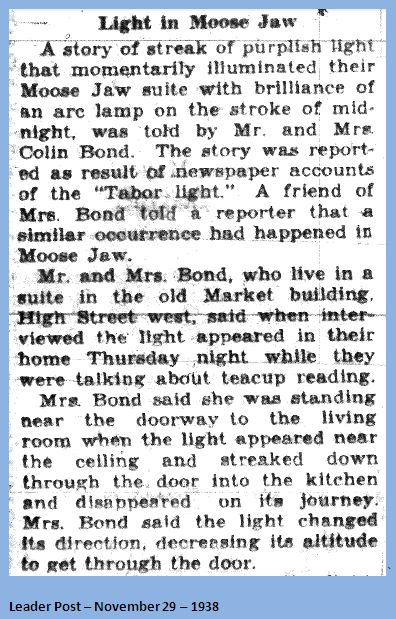
Maybe it was a Hessdalen-style phenomenon? Ball lightning? A successful prank?
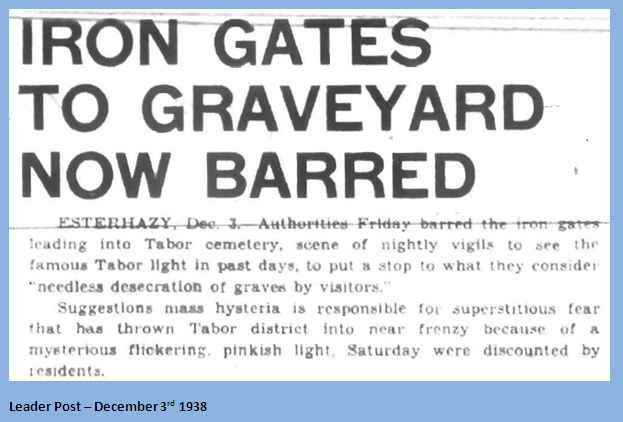
I haven't found any independent images of the cemetery or adjacent roads which has made it difficult to rule anything out. Having to take the witness reports at face value leaves a solution unlikely.
It's possible that a momentum was built up around the story that saw anything unusual being associated with the Light. For example, some miles away a couple had the experience of a purple light moving through their apartment. Whilst it's an unusual report, it's difficult to see what it had to do with the light at Tabor.

Maybe it was a Hessdalen-style phenomenon? Ball lightning? A successful prank?

The 'Saskatchewan Files' are available through the Wayback Machine if you enter 'http://saskfiles.com/'
a reply to: Kandinsky
Wow! Nice post! I am glad you shared your link on Marie's post. You also did a amazing job putting your work and words together. I can really appreciate and understand why and how it came together.
I thank you for your awesome post!
Wow! Nice post! I am glad you shared your link on Marie's post. You also did a amazing job putting your work and words together. I can really appreciate and understand why and how it came together.
I thank you for your awesome post!
edit on 3 29 2016 by Quantum12 because: (no reason given)
a reply to: Quantum12
Thank you for reading it. The journalist has moved on and the files may be lost. I'm planning to check an old hard drive in case the files are saved.
These localised events only seem to exist in the regional newspapers. When they're gone, the memories go too.
Thank you for reading it. The journalist has moved on and the files may be lost. I'm planning to check an old hard drive in case the files are saved.
These localised events only seem to exist in the regional newspapers. When they're gone, the memories go too.
originally posted by: Quantum12
a reply to: Kandinsky
That is sad. It took someone like you to keep it alive and to me
It seems like you put your heart and soul into your project!
At the time, I had a lot of email traffic with Rick Fowler and reached out to a few journalists in the area. Rick did a great service to us by running his site for as long as he did. It's only a short OP and it took a few weeks of reading and emails before putting it together.
I sorta wish more time had been spent on formatting the images and writing it with more feeling. C'est la vie!
Very interesting stuff you placed in ATS Kandinsky
This does sound like a real white type ufo orb just playing games and having fun with some human beings. From the description it is probably not marsh gas, electrical discharge or train lights. It sounds like the true light.
Awesome that this was being seen in 1938 These things have always been with us. The attempt to discover what it is well these things seem to defy explanation and are literally over our heads. Interesting that it was seen in a church yard, you do hear of people seeing them in burial areas so we tie these lights with spirit/ghosts/afterlife but what do we know? I've personally been quite into these lights years ago and never reeally got to the bottom of them in a ny way, indeed they get more perplexing the longer you get into them, the whole spirit thing seems credible at first but after a while they seem to be too real/too bright in life and light to be connected with death and rotting corpses. Then the apace ship connection, is there something connected between church yards and space ships? Answers go out the window and you just stand back and enjoy the beauty of these lights
This does sound like a real white type ufo orb just playing games and having fun with some human beings. From the description it is probably not marsh gas, electrical discharge or train lights. It sounds like the true light.
Awesome that this was being seen in 1938 These things have always been with us. The attempt to discover what it is well these things seem to defy explanation and are literally over our heads. Interesting that it was seen in a church yard, you do hear of people seeing them in burial areas so we tie these lights with spirit/ghosts/afterlife but what do we know? I've personally been quite into these lights years ago and never reeally got to the bottom of them in a ny way, indeed they get more perplexing the longer you get into them, the whole spirit thing seems credible at first but after a while they seem to be too real/too bright in life and light to be connected with death and rotting corpses. Then the apace ship connection, is there something connected between church yards and space ships? Answers go out the window and you just stand back and enjoy the beauty of these lights
a reply to: ufoorbhunter
Yeah, these reports have threaded through the folklore of people across the world. Brazilian Chupas, Japanese Furaribi, will o the wisps, Chinese lanterns and pixies.
Taken as a whole, they seem to cancel each other out and undermine popular explanations.
Yeah, these reports have threaded through the folklore of people across the world. Brazilian Chupas, Japanese Furaribi, will o the wisps, Chinese lanterns and pixies.
Then the apace ship connection, is there something connected between church yards and space ships? Answers go out the window and you just stand back and enjoy the beauty of these lights
Taken as a whole, they seem to cancel each other out and undermine popular explanations.
a reply to: Kandinsky
Following people along lanes/also along side. That following along side, that really happens, they sort of bobble along to your side a bit like a dog would and at about dog height. Sort of zigzigging around obstacles such as trees as they pace along side you.
The train theory. I just can't see the bit now but I'm sure I read more common coming from the north, well these lights generally do come from the north north west.............. For whatever reason
Following people along lanes/also along side. That following along side, that really happens, they sort of bobble along to your side a bit like a dog would and at about dog height. Sort of zigzigging around obstacles such as trees as they pace along side you.
The train theory. I just can't see the bit now but I'm sure I read more common coming from the north, well these lights generally do come from the north north west.............. For whatever reason
new topics
-
What if this is true?
2024 Elections: 3 minutes ago -
Merry-Go-Round Ride
Short Stories: 1 hours ago -
It's toast
General Chit Chat: 5 hours ago -
Man Stabbed or Cardiac arrest on Westminster Bridge, London, UK
Mainstream News: 7 hours ago -
A fix for the Trans players in sports
Social Issues and Civil Unrest: 9 hours ago
top topics
-
Petition Calling for General Election at 564,016 and rising Fast
Political Issues: 12 hours ago, 14 flags -
A fix for the Trans players in sports
Social Issues and Civil Unrest: 9 hours ago, 14 flags -
Man Stabbed or Cardiac arrest on Westminster Bridge, London, UK
Mainstream News: 7 hours ago, 7 flags -
It's toast
General Chit Chat: 5 hours ago, 7 flags -
Merry-Go-Round Ride
Short Stories: 1 hours ago, 3 flags -
What if this is true?
2024 Elections: 3 minutes ago, 0 flags
active topics
-
Russia Ukraine Update Thread - part 3
World War Three • 6876 • : worldstarcountry -
What if this is true?
2024 Elections • 0 • : Xerleh2 -
Petition Calling for General Election at 564,016 and rising Fast
Political Issues • 65 • : Oldcarpy2 -
It's toast
General Chit Chat • 9 • : Bluntone22 -
Merry-Go-Round Ride
Short Stories • 2 • : argentus -
Results of the use of the Oreshnik missile system in Dnepropetrovsk
World War Three • 216 • : Oldcarpy2 -
A fix for the Trans players in sports
Social Issues and Civil Unrest • 18 • : Tolkien -
Inca stone masonry at Sacsayhuaman, Ollantaytambo and the Sun Temple
Ancient & Lost Civilizations • 16 • : xxtrapsxx -
Well we know Putins ICBMs won't fail in their silos
World War Three • 214 • : 777Vader -
Well, here we go red lines crossed Biden gives the go ahead to use long range missiles
World War Three • 344 • : Xtrozero

